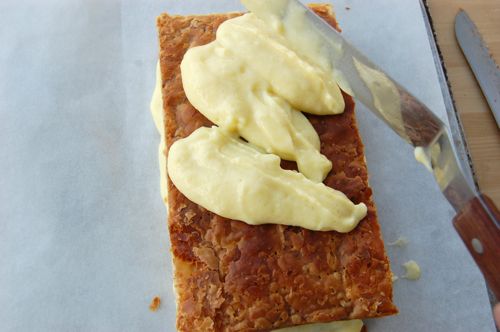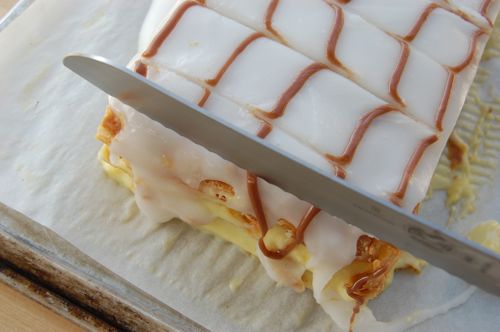But first, a counter-example.
All of you who’ve been after me to put up more of my missteps and mistakes — I’ve traditionally demurred as a thorough log would require at least one, if not several more, blogs — today is your day. Yesterday’s Napoleon fiasco is worth noting if only as an illustration of the ways in which pastry-making and architecture are related.
What happened? I attempted to make a batch of Napoleons with a pastry cream of insufficient thickness, is what. Had I stuck with my standard preparation, all might have been well. But no, I had to go and get all fancy with a new French iteration with less starch and more yolks. It came with assurances that it had the stuff to support two stories of pastry. It was creamy and luscious, but turned out not to have the stuff to maintain my structure. Have a look:

See? Laying it on you can see its tendency to run. That doesn’t make it bad. This slightly-runny cream would be wonderful in, say, Paris-Brest. But look how it wants to ooze out in all directions, despite my attempts to shore it up. I pressed ahead anyway since my pastry sheets were already damp.

I knew I was losing integrity at this point, since the top layer was ever-so-slowly trying to slip off. I got all the way to the trimming, hoping to eke out maybe one good Napoleon for a photo, when the whole thing fell apart in a sloppy heap. It happened about a tenth of a second after I took this.

No, I didn’t get a picture of the aftermath. I was too busy cursing like a longshoreman. And I threw the whole thing out in frustration before it occurred to me that my fiasco might have educational value. next time I’ll remember to preserve my screw-ups for posterity. I mean really, why should my wife and daughters be the only witnesses to my failings? There’ll be more where this came from.
id have eaten it
What can I say, I was aggravated. Mrs. Pastry wasn’t happy I’d dumped it, either.
Your across the street neighbors are retroactively angry.
What can I say? I was frustrated. Sorry.
Thanks for this Joe. I often know that we are all not perfect. And it helps us to know that there are others out there too, that things don’t always go perfectly. Its a learning experience for everyone. I do love Napoleon’s!
Thanks Sharon! I appreciated that. Hopefully I’ll produce some decent ones later in the week! – Joe
Man – that’s a scandal throwing it out! It all looks the same in your tummy 🙂
Truthfully, I think I would have thrown the mess into a bowl and eaten it anyway!
I think it’s all well and good that you are leading your readers down some of the more adventuresome pathways of Continental baking. I would think, however, it would behoove you as a pastry historian to first get your facts straight, in this case, about the origins of the Napoleon. You said it had nothing to do with the famous French Emperor. But didn’t you see Woody Allen’s “Love and Death?” It contains a scene which plainly documents the birth of the dessert, clearly showing how an agitated Bonaparte insisted that his chefs finish inventing his eponymous pastry before his rival, the Duke of Wellington, was able to complete work on his new beef dish.
Second, I am concerned that this posting perpetuates the fiction that people who are neither bloggers nor classically-trained pastry chefs are actually capable of making puff pastry at home. I have tried to four times, and it gets worse every time. Come clean: Home made puff pastry is a myth perpetuated by the National Unsalted Butter Council to increase sales, isn’t it?
Finally, I wish to bring to your attention the fact that studies by linguists at a number of leading universities have proven that both “mille-feuille and “pate feuilletee” are impossible to pronounce, even for French people.
What can I say, Reader Lee? Your impeccably researched retort leaves me no room to maneuver. I concede the point. But not on the puff pastry. I’m starting to think I need to do a traveling road show on making laminated pastry at home. A lot of people tell me the same thing you just did, but in truth once you see it done and/or try it yourself it’s startling how easy the process really is. I’ll also say that you CAN make Napoleons with store bought pastry if you want. I’ll make notes in the final tutorial…assuming I can get these things made correctly this week.
Making puff pastry at home just takes patience….it is relatively easy, its just time consuming.
Thank you for this one!
My shade of green became slightly milder!
Truly, flaky pastry is not difficult, just time consuming. I’m not any sort of trained cook, but have made my own flaky pastry all my life. Or at least since I was old enough to want to use it. I can remember using bought flaky pastry only once – making sausage rolls for my father’s funeral. I just couldn’t cope with the volume of pastry needed, and in someone else’s kitchen at that. I even used the stuff that comes ready-rolled.
It brings to mind one of my mother’s favourite expressions when the presentation went poorly (like runny fruit pies) — “well at least the ingredients are wholesome”. I would have eaten your Napoleons regardless of what they looked like.
Ha! Thanks Cathy!
napoleons. yuummm. i have a suggestion for you, one i was taught in pastry school. try glazing your last layer w/ fondant on a rack and let it dry before you top your napoleon off w/ it. and pipe your pastry cream out using a smallish round tip, that way you have uniform thickness! love your website, btw. it’s fantastic. 🙂
I’ll take those tips and use them! Thanks, Melinda!
Please ship all mistakes like this to my house. I’ve trained my kin to love & respect imperfection, and Napoleon SHOULD NEVER BE WASTED. (Cauliflower: OK to waste. Brussel sprouts: ditto. Puff pastry & creamy layers: NEVVVVVER.)
Point taken, Tracy! It won’t happen again!
Joe,
I’ve thrown out things when I wasn’t perfectly happy with them, too. Pastries that were certainly edible, but nothing I’d EVER consider photographing, much less serve to someone ELSE.
However, one day I made the mistake of TELLING a friend that I’d actually tossed out an entire chocolate cake one day because I’d rushed and didn’t bother to crumbcoat it and it was a MESS.
He quickly informed me that I wasn’t allowed to throw out pastries EVER AGAIN and no matter WHAT it looked like, to call him immediately if said pastry was in danger of going into the trashbin and he would make sure it was given a good home (his belly).
So kudos to you for being so brave in sharing your less than perfect attempt at napoleans. It makes me feel a lot better about my “mistakes.” 🙂
Hehe…yes. As you can see by the comments, I’m paying for my honestly about pitching the pastry. Mrs. Pastry gave me a lot of grief about it as well, as she abhors waste in all its forms. But there’ll be more of these sorts of posts as I’ve been getting a fair amount of requests for them (and I make plenty of mistakes). – Joe
I suggest two things when making Napoleons.
First, glaze and cut the top layer into serving sized pieces before you stack it all together, much like you did with the Paris Brest.
Second, pop the whole kit and kaboodle into the freezer for an hour before you try to cut it with a hot, wet chef’s knife. Use a quick downward cut.
Having the top already cut eliminate the need for the serrated knife, and freezing it makes the whole messy job a whole lot cleaner.
🙂
Good luck with round two!
I’m sorry this napoleon went awry, but the pic of the classic marbling on top is an excellent example of how it’s done on traditional European tortes, pastries, etc. I mention this sort of look in several of my posts where I show how to make “non-traditional” marbled heart shapes on some cookies, so, if you don’t mind, I’m going to add a hotlink to this page so folks can see the classic way, too. Bottom line–thanks for this post, as this pic is very handy for me right now!
Sure, Nancy! I hope to have a good batch of Napoleons done over the weekend…but you never know!